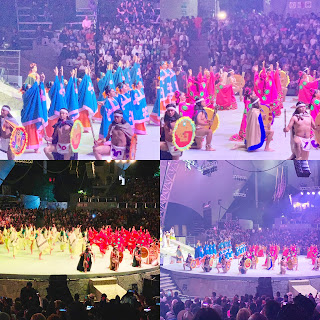According to our tour guide, Monte Albán is the most important site for Oaxaca people. And after reading so much about this and that in relation to Oaxaca, I happen to agree.
Monte Albán is a big stunning archeological site. It's architecture is unique and also resembles the architecture found in Teotihuacán (Aztec Empire). There is a reason for that and it has to do with how the Aztec Empire won wars against other Indigenous groups and also about the many treaties made through commerce.
Monte Albán was the most important capital city for the Zapotec (Oaxaca Indigenous people) and it was built on a mountain overlooking the valley where the capital of the state is today. According to research, Monte Albán was the main city from about 700 BCA until sometime in the 9th century.
Monte Albán's original name was, for the mexica: Ocelotepec (Jaguar Mountain), for the Zapotec it was Dani Beexde (also meaning Jaguar Mountain), and for the Mixtec it was known as Yúcu-cúi, which means Green Mountain. Today's name was given by the Spanish colonizers because the views from Monte Albán resemble the views and mountains of the Italian Alps.
One of the most impressive findings in Monte Albán, at least to me, is the many flat rock drawings of warrior prisoners who were castrated and then, "drawn" to be remembered by the enemies. "This will happen to you too!" It's just fascinating.
Oaxaca is known for its Alebrijes. But the birth of such colorful figurines isn't in Oaxaca but in Mexico City. For those who do not know what an alebrije is, here's a picture:
Now, an alebrije isn't just a cute figurine. There is a very long history about what an alebrije is and what it means so...
In the beginning, there was a man, Pedro Linares López, who lived in Mexico City. At some point he got very sick and for a period of time he went into an "unconscious state." While family members thought he was going to die, Pedro Linares López was actually in a fantastical journey through the woods where a variety of strange creatures lived. These fantastical creatures helped him get out of the woods and into the light (conciseness).
These journey had a great significance for Pedro. First of all, he saw creatures he had never seen in his life, donkeys with wings, lions with dog heads, roosters with with horns, and so many other strange animals that he couldn't describe. Second, the creatures were walking with him guiding him through the woods, helping him find his way. And third, while walking with Pedro, the creatures kept mentioning just one word: "alebrijes." When Pedro Linares López gained consciousness, the first words out of his mouth were "Alebrijes! Alebrijes!"
Pedro was a "cartonero" (a person who collects cardboard boxes on the street in order to sell them). His experience as a cartonero gave him the ability to manipulate cardboard in many ways. After his vision, he used the cardboard to shape it into the many figures he saw. He then painted them in many colors. He called his artistic creations, "alebrijes."
Slowly, his visionary creations started to appear in Mexico City, then in the country and soon in Europe, Asia and later in the United States. Pedro Linares López went from a very poor man (a cartonero) to a world renown artist in just a few years. His family also became artists and Pedro taught his children how to make paper maché alebrijes.
In 1990, Pedro received the National Arts & Sciences Prize for his artistic work and for his contribution to the arts, nationally and internationally. By the time Pedro Linares López died (in 1992), he created a family of alebrije artists who would continue his vision to today.
So, how does Oaxaca becomes to be known as the place for alebrijes? Pedro Linares López gave many workshops around the country and the many people from Oaxaca learned Pedro's technique. With the time, the Oaxaca artists mixed their carving wood techniques with Pedro's paper maché techniques, perfecting craft. Oaxaca alebrijes are made of wood while Mexico City alebrijes are made of paper maché.
One thing to remember is that the process of making an alebrije takes at least a month, whether it is made of paper or wood, each step is carefully followed and time is given for both the paper and wood to be ready to use for shaping and painting.
One more thing to remember is that each alebrije is unique, no two alebrijes will ever be same, and that has to do with the artists using their imagination to create/carve/paint/decorate each piece. True alebrijes (both paper and wood) are made as single unit, there are no molds to make them. Also each piece is painted/decorated by a single person so no two alebrijes will ever look similar at all.
Alebrijes take time to make and they are made by one single person they can take at least a month to make (depending of its size) or even up to six months. The smaller the piece, the expensive it can become because of its intricate design. Big pieces are also expensive, but not for the carving but for the painting decoration because the techniques and details are so incredibly well done that it does take a true artist to come out with such beautiful pieces.
NEXT:
LUNES DE CERRO (Mondays on the Hill) LA GUELAGUETZA PRESENTATION!






































